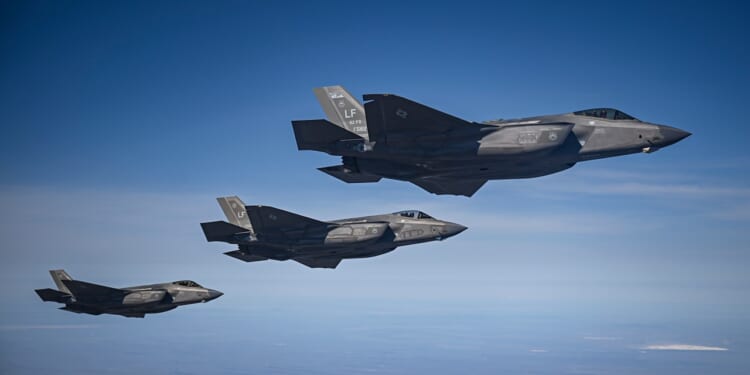By selling F-35s to allied nations, America provides them with one of the world’s most effective fighter jets—and an ironclad economic connection to the US defense industry.
No modern aircraft has been as politically or industrially successful as the F-35 Lightning II. Conceived in the 1990s as a cost-sharing platform capable of performing as a jack of all trades, the F-35 has since become a cornerstone of Western defense integration, a platform that binds the US, Europe, and pacific allies through shared technology.
The F-35 Lightning II’s Specifications
- Year Introduced: 2015 (F-35A IOC with U.S. Air Force)
- Number Built: 1,200+ (3,000+ projected future production)
- Length: 51 ft 4 in (15.67 m)
- Wingspan: 35 ft (10.7 m) — F-35C: 43 ft (13.1 m)
- Weight (MTOW): ~70,000 lb (31,800 kg); slight variations between variants
- Engine: One Pratt & Whitney F135 afterburning turbofan (~43,000 lbf thrust with afterburner)
- Top Speed: Mach 1.6 (~1,200 mph / 1,930 km/h)
- Range:
- F-35A ~1,350 nmi (1,550 mi / 2,500 km)
- F-35B ~900 nmi (1,035 mi / 1,660 km)
- F-35C ~1,200 nmi (1,380 mi / 2,220 km)
- Combat Radius: ~670 nmi (770 mi / 1,240 km)
- Service Ceiling: 50,000 ft (15,240 m)
- Loadout:
- 1 × GAU-22/A 25 mm four-barrel cannon (180 rds internal on A model, gun pod for B/C)
- Internal bays for ~5,700 lb (2,590 kg) of ordnance
- External hardpoints for ~18,000 lb (8,160 kg) when stealth not required
- Aircrew: 1
The F-35 Has a Massive Share of the Fifth-Gen Fighter Market
Consider the numbers. More than 20 countries have purchased, or committed to purchasing, the F-35. The United Kingdom, Italy, Australia, Finland, Switzerland, and Japan have all bought the fighter aircraft. Over 1,200 F-35 have already been delivered around the world, with total production expected to exceed 3,000 units. The broader context of the moment, in an era of polarized politics and fraying alliances, makes the F-35’s political success all the more impressive.
The F-35’s export success stems from multiple, overlapping factors—capability, interoperability, and politics. Technologically, the F-35 is a performer, at an advantage as the only fifth-generation stealth fighter available to US allies, offering radar-evading design with advanced sensors and a level of data fusion that sets the industry standard. The F-35 gives procuring air forces a significant leap in situational awareness and survivability, something fourth-generation exports, like the F-16 or the Dassault Rafale or the Su-30, simply can’t match. No other aircraft on the export market offers comparable stealth and networking.
Further enhancing the F-35’s market appeal is interoperability. Every F-35 is designed to plug directly into the US command-and-control ecosystem—to share targeting data, threat libraries, and maintenance standards. For allies, that means instant compatibility with US operations. And for Washington, that means when allies join the US in combat, those allies will be operating with American software, tactics, and systems. Basically, each and every F-35 is a networked node in a shared digital battlespace that the US oversees.
Last, the program was strutted as an international project, where partner nations paid into development and manufacturing. The distributive effort created an atmosphere of political buy-in where countries that participate in the funding and actual construction of the F-35 are committed to buying the finished product. The result is a more enduring global supply chain—but one that is firmly anchored to the United States.
F-35 Exports Have Strategic Implications for America
Strategically, the F-35’s mass export success creates an advantage for the United States—whose allies now have US-compatible stealth aircraft, whereas adversaries still mostly rely on fourth-generation fleets, or, in the case of Russia and China, indigenous stealth projects. And given the data-sharing capabilities of the F-35, the platform serves as a force multiplier, creating a vast network of sensors and communications that acts as a deterrent.
The F35’s diffusion comes with risk. The global sprawl of the program creates vulnerabilities and exposures. The global supply chain creates dependencies that are beyond US control. And the entrenchment of the program limits future political flexibility; when the time comes that the F-35 is outdated, the program will likely prove difficult to kill, given the vast number of stakeholders with a financial interest in keeping it alive. But for the moment, the F-35 is a prime example of US military-industrial-political influence on the global stage, the cornerstone combat aircraft for the entire Western world.
About the Author: Harrison Kass
Harrison Kass is a senior defense and national security writer at The National Interest. Kass is an attorney and former political candidate who joined the US Air Force as a pilot trainee before being medically discharged. He focuses on military strategy, aerospace, and global security affairs. He holds a JD from the University of Oregon and a master’s in Global Journalism and International Relations from NYU.
Image: Shutterstock / rikinik.
















